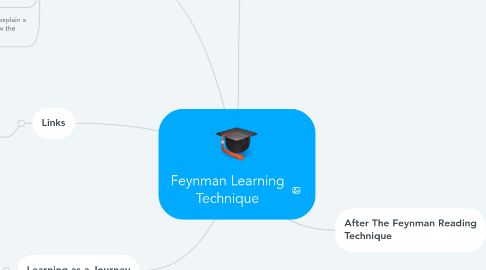Feynman Learning Technique
by Darshna Rekha

1. Steps
1.1. Take a blank sheet of paper and write the subject/topic name on the top.
1.2. Write everything you know about the subject/topic on the paper. Fill it like you would be teaching it to a kid or a rubber duck.
1.3. Find gaps in you understanding.
1.4. Fill the gaps by going back to the reading material and try writing it down again.
1.5. Repeat until you have no gaps in explaining the subject/topic.
1.6. Organize the notes and simplify it further, if possible.
1.7. Explain or readout to someone who knows about the topic and get feedback.
1.8. Teach (Optional)
2. Information
2.1. It is a reading technique to understand a topic better.
2.2. It knocks on the idea that to understand something you should be able to teach it to anyone.
2.3. Kids have limited vocabulary. If you understand something you can explain using the most basic words.
2.4. Using big words or not able to explain a concept means you do not know the topic well.
3. After The Feynman Reading Technique
3.1. Decide whether someone else truly knows their stuff or is mimicking others.
3.2. Dealing with uncertainty: Very few ideas in life are absolutely true. What you want is to get as close to the truth as you can with the information available.
3.3. Realization that as we investigate whether something is true or not, new evidence and new methods of experimentation should show the effect of getting stronger and stronger, not weaker. Knowledge is not static, and we need to be open to continually evaluating what we think we know.
3.4. Ask the right question, which is not “Could this be the case?” but “Is this actually the case?” Many get so caught up with the former that they forget to ask the latter.
3.5. You cannot judge the probability of something happening after it’s already happened. That’s cherry-picking. You have to run the experiment forward for it to mean anything.
3.6. The plural of anecdote is not data. We must use proper statistical sampling to know whether or not we know what we’re talking about.
3.7. Realize that many errors people make simply come from lack of information. They don’t even know they’re missing the tools they need. This can be a very tough one to guard against—it’s hard to know when you’re missing information that would change your mind.
4. Learning as a Journey
4.1. Knowing something is valuable. The more you understand about how the world works, the more options you have for dealing with the unexpected and the better you can create and capitalize on opportunities. The Feynman Learning Technique is a great method to develop mastery over sets of information. Once you do, the knowledge becomes a powerful tool at your disposal. But as Feynman himself showed, being willing and able to question your knowledge and the knowledge of others is how you keep improving. Learning is a journey.
5. Links
5.1. The Feynman Learning Technique By Farnam Street.


